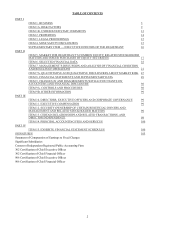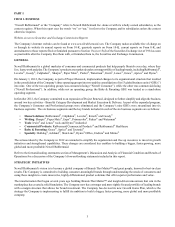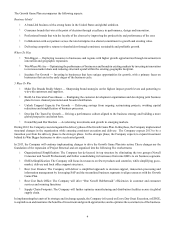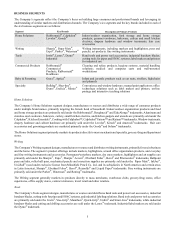Graco 2012 Annual Report Download - page 18
Download and view the complete annual report
Please find page 18 of the 2012 Graco annual report below. You can navigate through the pages in the report by either clicking on the pages listed below, or by using the keyword search tool below to find specific information within the annual report.12
processing and utilizing information. In addition, this conversion will impact certain interfaces with the Company's customers and
suppliers, resulting in changes to the manner in which the Company takes orders, procures materials, schedules production, remits
billings, makes payments and performs other business functions. Based upon the complexity of this initiative, there is risk that
the Company will be unable to complete the implementation in accordance with its timeline and will incur additional costs. The
implementation could result in operating inefficiencies, and the implementation could impact the Company's ability to perform
necessary business transactions, including its ability to supply products on a timely basis. The Company's go-lives have been and
will continue to be in a phased approach to reduce the risk of business disruption throughout the Company's business units and
regions. However, there can be no assurance that the risk of business disruption can be eliminated with the Company's phased
approach. All of these risks could adversely impact the Company's results of operations, financial condition and cash flows.
Impairment charges could have a material adverse effect on the Company's financial results.
Future events may occur that would adversely affect the reported value of the Company's assets and require impairment charges.
Such events may include, but are not limited to, strategic decisions made in response to changes in economic and competitive
conditions, the impact of the economic environment on the Company's sales and customer base, the unfavorable resolution of
litigation, a material adverse change in the Company's relationship with significant customers or business partners, or a sustained
decline in the Company's stock price. The Company continues to evaluate the impact of economic and other developments on the
Company and its business units to assess whether impairment indicators are present. Accordingly, the Company may be required
to perform impairment tests based on changes in the economic environment and other factors, and these tests could result in
impairment charges in the future.
The Company's businesses are subject to regulation in the U.S. and abroad.
Changes in laws, regulations and related interpretations may alter the environment in which the Company does business. This
includes changes in environmental, competitive and product-related laws, as well as changes in accounting standards, taxation
and other regulations. Accordingly, the Company's ability to manage regulatory, tax and legal matters (including environmental,
human resource, product liability, patent and intellectual property matters), and to resolve pending legal matters without significant
liability could require the Company to take significant reserves in excess of amounts accrued to date or pay significant fines during
a reporting period, which could materially impact the Company's results. In addition, new regulations may be enacted in the U.S.
or abroad that may require the Company to incur additional personnel-related, environmental or other costs on an ongoing basis,
significantly restrict the Company's ability to sell certain products, or incur fines or penalties for noncompliance, any of which
could adversely affect the Company's results of operations. For example, the United States Consumer Product Safety Commission
continues to advocate for more strict design standards for window blinds that if implemented, would require the Company to
redesign all window blinds sold in the U.S. For certain products, redesign may not be possible or practical, and as a result, the
Company would lose revenues from the sales of such products.
As a U.S.-based multinational company, the Company is also subject to tax regulations in the U.S. and multiple foreign jurisdictions,
some of which are interdependent. For example, certain income that is earned and taxed in countries outside the U.S. is not taxed
in the U.S., provided those earnings are indefinitely reinvested outside the U.S. If these or other tax regulations should change,
the Company's financial results could be impacted.
The resolution of the Company's tax contingencies may result in additional tax liabilities, which could adversely impact
the Company's cash flows and results of operations.
The Company is subject to income tax in the U.S. and numerous jurisdictions outside the U.S. Significant estimation and judgment
is required in determining the Company's worldwide provision for income taxes. In the ordinary course of the Company's business,
there are many transactions and calculations where the ultimate tax determination is uncertain. The Company is regularly under
audit by tax authorities. Although the Company believes its tax estimates are reasonable, the final outcome of tax audits and related
litigation could be materially different than that reflected in its historical income tax provisions and accruals. There can be no
assurance that the resolution of any audits or litigation will not have an adverse effect on future operating results.
Product liability claims or regulatory actions could adversely affect the Company's financial results or harm its reputation
or the value of its end-user brands.
Claims for losses or injuries purportedly caused by some of the Company's products arise in the ordinary course of the Company's
business. In addition to the risk of substantial monetary judgments, product liability claims or regulatory actions could result in
negative publicity that could harm the Company's reputation in the marketplace, adversely impact the value of its end-user brands,
or result in an increase in the cost of producing the Company's products. The Company could also be required to recall possibly
defective products, which could result in adverse publicity and significant expenses. Although the Company maintains product
liability insurance coverage, potential product liability claims are subject to a self-insured retention or could be excluded under
























